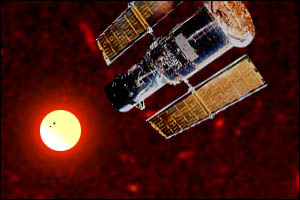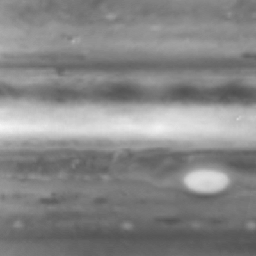Sign
My Guestbook
 View
My Guestbook
View
My Guestbook


Although the solar system is small when measured on the scale of the Universe,it is vast from the perspective of the Earth. Light which travels at 186,282 miles per second,takes 8.45 minutes to reach Earth from the Sun, it takes another five hours and 18 minutes to travel to pluto the last planet in the solar system. Over such huge distances there is much we can not see. But through the eyes of the hubble space telescope and missions like voyegers 1 and 2 and many more, we have seen the edges of the universe.
The Outter Planets

Jupiter the fifth planet is the first of the gas-type planets. It is the giant of the solar system, more than twice as massive as all the planets combined. The lightest gases,hydrogen and helium, make up 99 percent of the planet, The remaining one percent consists mostly of a rocky core about the size of Earth. Revolving on it's axis every 10 hours, this huge planet has the shortest day in the solar system. It's ice-and-ammonnia atmosphere contains one of Jupiters mysteries, the Great red spot. This prominent feature has baffeled astronomers since it was first seen 300 years ago, but astronomers now understand that it's a huge {three Earths Diameters}and long lived storm,though no one know how it started.
This prominent feature has baffeled astronomers since it was first seen 300 years ago, but astronomers now understand that it's a huge {three Earths Diameters}and long lived storm,though no one know how it started.

Saturn the sixth planet from the sun is surrounded by a whirling, 250,000-mile wide band of rings that are as thin as dust particles in some places. The rings are the most curious things about this giant planet, which is nine times Larger than Earth. Scientists are not sure what caused the rings to form but think that they came into exisitence the same time the planet was formed, some four billion years ago. When saturn began to take shape from the spinning cloud of gas and dust, some of the dust particle were not drawn into the mass, pehaps because they were too light. They continued to circle around the planet as they do today,like planitary debris.


In our solar system,almost every planet's axis of rotation pionts as Earth's does, roughly toward celestrial north. The seventh planet Uranus,is different. It makes its way through space on its side, like a top that has run down. It takes 84 years for uranus to orbit the Sun, causing one pole to be in perpetual darkness for 42 years and the other pole in light for 42 years. One possible explanation of this odd tilt is that Uranus was knocked sideways long ago when another body smashed into it. The remains of the exsplosive crash may have formed Uranis's moons and rings later. The voyager mission however found no evidence to prove this theory or to suggest another.

Votager2 flew past Neptune on august 24, 1989. Its cameras made thousands of pictures of the eighth planet and its largest moon Triton,which is three-quarters as big as earth's moon. Before leaving the solar system Voyager sent the pictures to Earth some 2.7 billion miles away. Data sent back indicated that Neptune is the windiest planet in the solar system with giant storms;the dark ovil is a storm systems wider than Earth. The space probe also detected white clouds of methane, four thin rings and six small moon besides triton & nereid,which were already known. But the real surprise was Titons images and data. Titon has no impact craters but a rugged landscape.Perhaps most amazing, triton with the coldest surface [-390 F.]has active volcanoes.

The outter planets are mostly gas-type planets. There is one exception to that rule. Pluto the ninth planet is a rock type planet. Not much is known about Pluto. No space probe has ever neared Pluto although voyager 1 came close on its fly by Neptune. The best image of Pluto and its only moon cheron came from Hubble.Pluto is the only known planet beyond mars that isn't a gas-type planet. Pluto's orbit is slightly different than any other planets orbit,swinging it inside of Neptune's orbit once ever cycle making it the eighth planet.This may explain why Pluto and it's only satellite cheron are rock type. One theory is that Pluto and it's moon which is nearly the same size may have once been moons of Neptune and broke away from the mother planet some time in its 4.6 billion year life.
came from Hubble.Pluto is the only known planet beyond mars that isn't a gas-type planet. Pluto's orbit is slightly different than any other planets orbit,swinging it inside of Neptune's orbit once ever cycle making it the eighth planet.This may explain why Pluto and it's only satellite cheron are rock type. One theory is that Pluto and it's moon which is nearly the same size may have once been moons of Neptune and broke away from the mother planet some time in its 4.6 billion year life.
Next the Inner planets

 This prominent feature has baffeled astronomers since it was first seen 300 years ago, but astronomers now understand that it's a huge {three Earths Diameters}and long lived storm,though no one know how it started.
This prominent feature has baffeled astronomers since it was first seen 300 years ago, but astronomers now understand that it's a huge {three Earths Diameters}and long lived storm,though no one know how it started.




